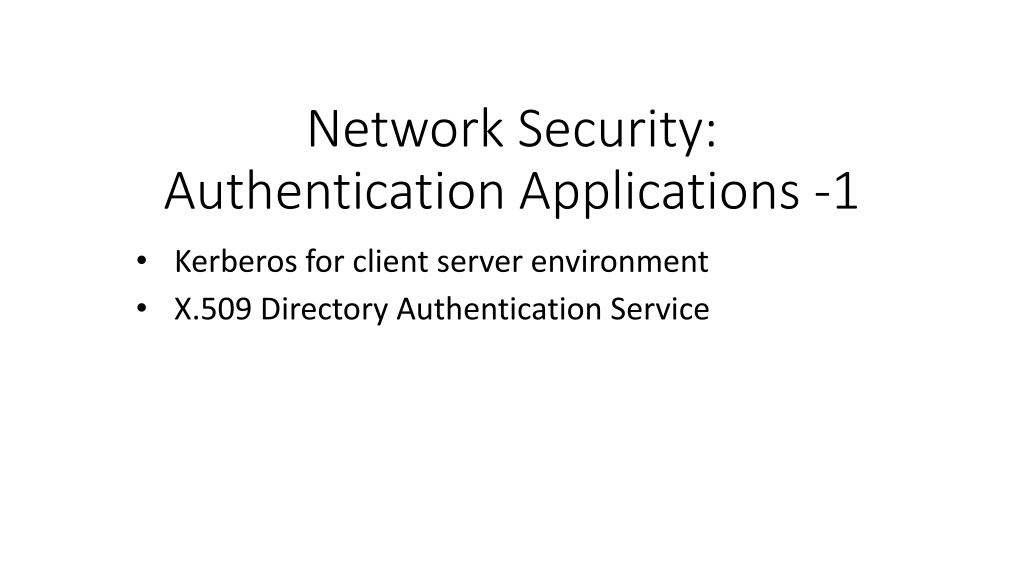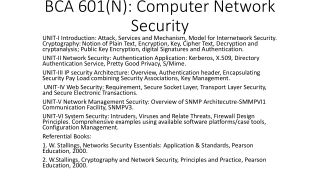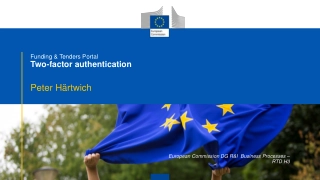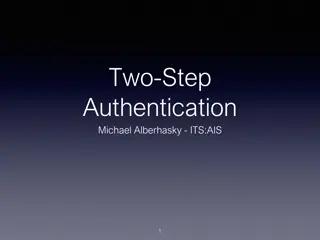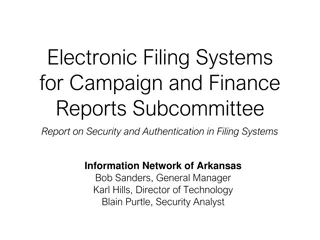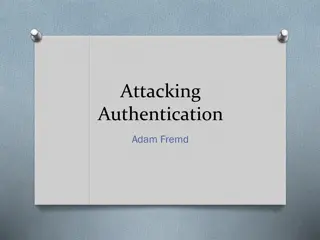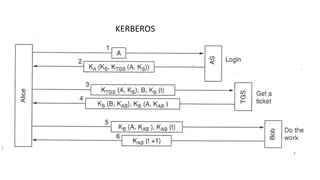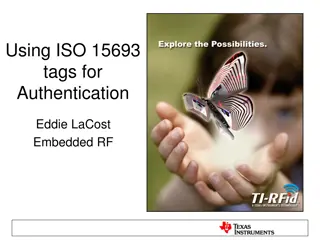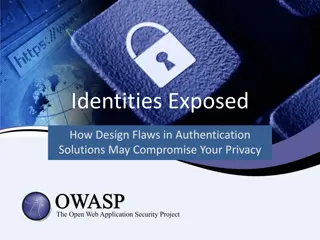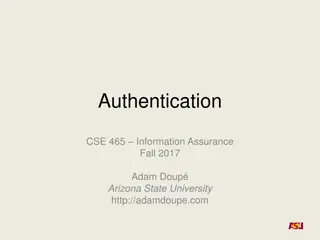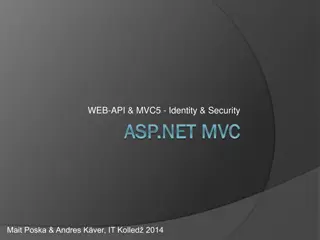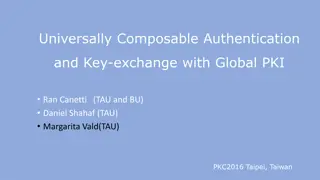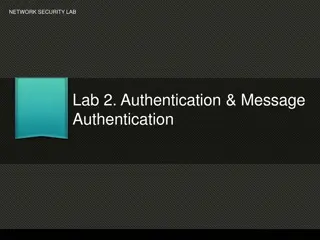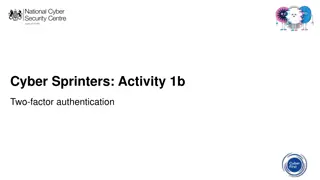Understanding Kerberos Authentication in Network Security
Kerberos is a trusted authentication service for establishing secure communication between clients and servers in a distributed environment. Developed at MIT, it addresses threats like user impersonation and eavesdropping by providing centralized authentication. Kerberos relies on symmetric encryption and has versions 4 and 5, with the latter addressing security deficiencies. This authentication protocol ensures that only authorized users access services and data in a network.
Download Presentation

Please find below an Image/Link to download the presentation.
The content on the website is provided AS IS for your information and personal use only. It may not be sold, licensed, or shared on other websites without obtaining consent from the author. Download presentation by click this link. If you encounter any issues during the download, it is possible that the publisher has removed the file from their server.
E N D
Presentation Transcript
Network Security: Authentication Applications -1 Kerberos for client server environment X.509 Directory Authentication Service
Many authentication functions have been developed to support network-based user authentication Mutual authentication protocols enable communicating parties to satisfy themselves mutually about each other s identity and to exchange session keys. Kerberos is an authentication service designed for use in a distributed environment. Kerberos provides a trusted third-party authentication service that enables clients and servers to establish authenticated communication. It uses symmetric encryption technique the X.509 user-authentication protocol rely on asymmetric encryption.
KERBEROS KERBEROS Kerberos4 is an authentication service developed as part of Project Athena at MIT. The problem that Kerberos addresses is this: Assume an open distributed environment in which users at workstations wish to access services on servers distributed throughout the network. We would like for servers to be able to restrict access to authorized users and to be able to authenticate requests for service. In this environment, a workstation cannot be trusted to identify its users correctly to network services. In particular, the following three threats exist: 1. A user may gain access to a particular workstation and pretend to be another user operating from that workstation. 2. A user may alter the network address of a workstation so that the requests sent from the altered workstation appear to come from the impersonated workstation. 3. A user may eavesdrop on exchanges and use a replay attack to gain entrance to a server or to disrupt operations. In any of these cases, an unauthorized user may be able to gain access to services and data that he or she is not authorized to access. Rather than building in elaborate authentication protocols at each server, Kerberos provides a centralized authentication server whose function is to authenticate users to servers and servers to users. Kerberos relies exclusively on symmetric encryption, making no use of public-key encryption. Two versions of Kerberos are in common use. Version 4 implementations still exist. Version 5 corrects some of the security deficiencies of version 4 and has been issued as a proposed Internet Standard (RFC 4120).
Kerberos: Motivation.. If a set of users is provided with dedicated personal computers that have no network connections, then a user s resources and files can be protected by physically securing each personal computer. When these users instead are served by a centralized timesharing system, the time-sharing operating system must provide the security. The operating system can enforce access-control policies based on user identity and use the logon procedure to identify users. Today, neither of these scenarios is typical. More common is a distributed architecture consisting of dedicated user workstations (clients) and distributed or centralized servers. In this environment, three approaches to security can be envisioned. 1. Rely on each individual client workstation to assure the identity of its user or users and rely on each server to enforce a security policy based on user identification (ID). 2. Require that client systems authenticate themselves to servers, but trust the client system concerning the identity of its user. 3. Require the user to prove his or her identity for each service invoked. Also require that servers prove their identity to clients. In a small, closed environment in which all systems are owned and operated by a single organization, the first or perhaps the second strategy may suffice. But in a more open environment in which network connections to other machines are supported, the third approach is needed to protect user information and resources housed at the server. Kerberos supports this third approach. Kerberos assumes a distributed client/server architecture and employs one or more Kerberos servers to provide an authentication service.
Summary of Kerberos version 4 Message exchanges
X.509 Directory authentication service ITU-T recommendation X.509 is part of the X.500 series of recommendations that define a directory service. The directory is, in effect, a server or distributed set of servers that maintains a database of information about users. The information includes a mapping from user name to network address, as well as other attributes and information about the users. X.509 defines a framework for the provision of authentication services by the X.500 directory to its users. The directory may serve as a repository of public-key certificates of the type discussed in Section 14.3. Each certificate contains the public key of a user and is signed with the private key of a trusted certification authority. In addition, X.509 defines alternative authentication protocols based on the use of public-key certificates. X.509 is an important standard because the certificate structure and authentication protocols defined in X.509 are used in a variety of contexts. For example, the X.509 certificate format is used in S/MIME (Chapter 18), IP Security (Chapter 19), and SSL/TLS
X.509: contd: X.509 is based on the use of public-key cryptography and digital signatures. The standard does not dictate the use of a specific algorithm but recommends RSA. The digital signature scheme is assumed to require the use of a hash function. Figure 14.13 (next slide) illustrates the generation of a public-key certificate. Certificates The heart of the X.509 scheme is the public-key certificate associated with each user. These user certificates are assumed to be created by some trusted certification authority (CA) and placed in the directory by the CA or by the user. The directory server itself is not responsible for the creation of public keys or for the certification function; it merely provides an easily accessible location for users to obtain certificates.
Elements of X.509 certificate format Version: Differentiates among successive versions of the certificate format; the default is version 1. If the issuer unique identifier or subject unique identifier are present, the value must be version 2. If one or more extensions are present, the version must be version 3. Serial number: An integer value unique within the issuing CA that is unambiguously associated with this certificate. Signature algorithm identifier: The algorithm used to sign the certificate together with any associated parameters. Because this information is repeated in the signature field at the end of the certificate, this field has little, if any, utility. Issuer name: X.500 is the name of the CA that created and signed this certificate. Period of validity: Consists of two dates: the first and last on which the certificate is valid. Subject name: The name of the user to whom this certificate refers.That is, this certificate certifies the public key of the subject who holds the corresponding private key. Subject s public-key information: The public key of the subject, plus an identifier of the algorithm for which this key is to be used, together with any associated parameters. Issuer unique identifier: An optional-bit string field used to identify uniquely the issuing CA in the event the X.500 name has been reused for different entities
Subject unique identifier: An optional-bit string field used to identify uniquely the subject in the event the X.500 name has been reused for different entities. Extensions: A set of one or more extension fields. Extensions were added in version 3 and are discussed later in this section. Signature: Covers all of the other fields of the certificate; it contains the hash code of the other fields encrypted with the CA s private key. This field includes the signature algorithm identifier. The unique identifier fields were added in version 2 to handle the possible reuse of subject and/or issuer names over time. These fields are rarely used. The standard uses the following notation to define a certificate: The CA signs the certificate with its private key. If the corresponding public key is known to a user, then that user can verify that a certificate signed by the CA is valid. This is the typical digital signature approach used here
